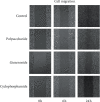Study on the Mechanism of Ginseng in the Treatment of Lung Adenocarcinoma Based on Network Pharmacology
- PMID: 32802118
- PMCID: PMC7415121
- DOI: 10.1155/2020/2658795
Study on the Mechanism of Ginseng in the Treatment of Lung Adenocarcinoma Based on Network Pharmacology
Abstract
Background: Ginseng, a traditional Chinese medicine, was used to prevent and treat many diseases such as diabetes, inflammation, and cancer. In recent years, there are some reports about the treatment of lung adenocarcinoma with ginseng monomer compounds, but there is no systematic study on the related core targets and mechanism of ginseng in the treatment of lung adenocarcinoma up to now. Therefore, this study systematically and comprehensively studied the molecular mechanism of ginseng in the treatment of lung adenocarcinoma based on network pharmacology and further proved the potential targets by A549 cell experiments for the first time.
Methods: The targets of disease and drug were obtained from Gene database. Subsequently, the compound-target network was constructed, and the core potential targets were screened out by plug-in into Cytoscape. Furthermore, the core targets and mechanism of ginseng in the treatment of lung adenocarcinoma were verified by MTT test, cell scratch test, immunohistochemistry, and qRT-PCR.
Results: 1791 disease targets and 144 drug targets were obtained by searching the Gene database. Meanwhile, 15 core targets were screened out: JUN, MAPK8, PTGS2, CASP3, VEGFA, MMP9, AKT1, TNF, FN1, FOS, MMP782, IL-1β, IL-2, ICAM1, and HMOX1. The results of cell experiments indicate that ginseng could treat lung adenocarcinoma by cell proliferation, migration, and apoptosis. In addition, according to the results of the 15 core targets by qRT-PCR, JUN, IL-1β, IL-2, ICAM1, HMOX1, MMP9, and MMP2 are upregulated core targets, while PTGS2 and TNF are downregulated core targets.
Conclusion: This study systematically and comprehensively studied 15 core targets by network pharmacology for the first time. Subsequently, it is verified that 9 core targets for ginseng treatment of lung adenocarcinoma, namely, JUN, IL-1β, IL-2, ICAM1, HMOX1, MMP9, MMP2, PTGS2, and TNF, are closely related to the proliferation, migration, and apoptosis of lung adenocarcinoma cells. This study has reference value for the clinical application of ginseng in the treatment of lung adenocarcinoma.
Copyright © 2020 Qiu-Yue Li et al.
Conflict of interest statement
The authors declare no conflicts of interest.
Figures






Similar articles
-
[Analysis of anti-fatigue mechanism and potential targets of ginseng].Zhongguo Zhong Yao Za Zhi. 2019 Dec;44(24):5479-5487. doi: 10.19540/j.cnki.cjcmm.20190805.401. Zhongguo Zhong Yao Za Zhi. 2019. PMID: 32237398 Chinese.
-
Clinical efficacy and potential mechanism of ginseng polysaccharides in the treatment of non-small cell lung cancer based on meta-analysis associated with network pharmacology.Heliyon. 2024 Mar 7;10(6):e27152. doi: 10.1016/j.heliyon.2024.e27152. eCollection 2024 Mar 30. Heliyon. 2024. PMID: 38496882 Free PMC article.
-
Molecular Targets and Mechanisms of Scutellariae radix-Coptidis rhizoma Drug Pair for the Treatment of Ulcerative Colitis Based on Network Pharmacology and Molecular Docking.Evid Based Complement Alternat Med. 2021 Jun 4;2021:9929093. doi: 10.1155/2021/9929093. eCollection 2021. Evid Based Complement Alternat Med. 2021. PMID: 34149863 Free PMC article.
-
[Effect of "Hedyotis Diffusae Herba-Smilacis Glabrae Rhizoma" in treatment of lung adenocarcinoma based on network pharmacology].Zhongguo Zhong Yao Za Zhi. 2021 Dec;46(23):6261-6270. doi: 10.19540/j.cnki.cjcmm.20210913.401. Zhongguo Zhong Yao Za Zhi. 2021. PMID: 34951253 Chinese.
-
Exploration of the mechanism of Zisheng Shenqi decoction against gout arthritis using network pharmacology.Comput Biol Chem. 2021 Feb;90:107358. doi: 10.1016/j.compbiolchem.2020.107358. Epub 2020 Aug 8. Comput Biol Chem. 2021. PMID: 33243703 Review.
Cited by
-
Systematic exploration of therapeutic effects and key mechanisms of Panax ginseng using network-based approaches.J Ginseng Res. 2024 Jul;48(4):373-383. doi: 10.1016/j.jgr.2024.01.005. Epub 2024 Jan 24. J Ginseng Res. 2024. PMID: 39036729 Free PMC article.
-
The ethyl acetate extract of Wenxia Changfu Formula inhibits the carcinogenesis of lung adenocarcinoma by regulating PI3K-AKT signaling pathway.Sci Rep. 2023 Mar 22;13(1):4715. doi: 10.1038/s41598-023-31924-x. Sci Rep. 2023. PMID: 36949111 Free PMC article.
-
Network Pharmacology of Ginseng (Part II): The Differential Effects of Red Ginseng and Ginsenoside Rg5 in Cancer and Heart Diseases as Determined by Transcriptomics.Pharmaceuticals (Basel). 2021 Sep 30;14(10):1010. doi: 10.3390/ph14101010. Pharmaceuticals (Basel). 2021. PMID: 34681234 Free PMC article.
-
A Randomized, Multi-Center, Open Label Study to Compare the Safety and Efficacy between Afatinib Monotherapy and Combination Therapy with HAD-B1 for the Locally Advanced or Metastatic NSCLC Patients with EGFR Mutations.Integr Cancer Ther. 2024 Jan-Dec;23:15347354241268231. doi: 10.1177/15347354241268231. Integr Cancer Ther. 2024. PMID: 39103991 Free PMC article. Clinical Trial.
-
Regulatory Mechanism and Experimental Verification of Patchouli Alcohol on Gastric Cancer Cell Based on Network Pharmacology.Front Oncol. 2021 Sep 1;11:711984. doi: 10.3389/fonc.2021.711984. eCollection 2021. Front Oncol. 2021. PMID: 34540679 Free PMC article.
References
-
- Torre L. A., Bray F., Siegel R. L., Ferlay J., Lortet-Tieulent J., Jemal A. Global cancer statistics, 2012. CA: A Cancer Journal for Clinicians. 2015;65(2):87–108. - PubMed
-
- Allemani C., Weir H. K., Carreira H., et al. Global surveillance of cancer survival 1995-2009: analysis of individual data for 25 676 887 patients from 279 population-based registries in 67 countries (CONCORD-2) The Lancet. 2015;385(9972):977–1010. doi: 10.1016/s0140-6736(14)62038-9. - DOI - PMC - PubMed
LinkOut - more resources
Full Text Sources
Research Materials
Miscellaneous

